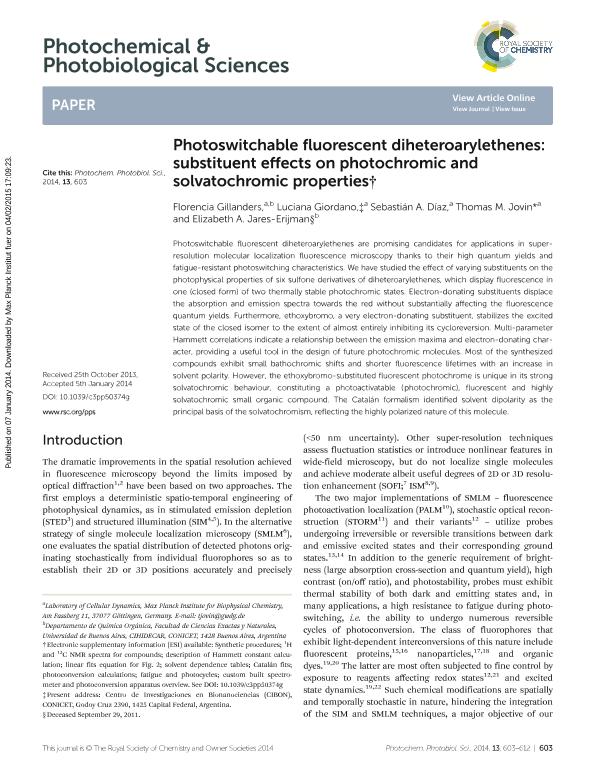Mostrar el registro sencillo del ítem
dc.contributor.author
Gillanders, Florencia

dc.contributor.author
Giordano, Luciana

dc.contributor.author
Diaz, Sebastian Andres

dc.contributor.author
Jovin, Tomás

dc.contributor.author
Jares, Elizabeth Andrea

dc.date.available
2016-02-10T15:48:13Z
dc.date.issued
2014-01
dc.identifier.citation
Gillanders, Florencia; Giordano, Luciana; Diaz, Sebastian Andres; Jovin, Tomás; Jares, Elizabeth Andrea; Photoswitchable fluorescent diheteroarylethenes: substituent effects on photochromic and solvatochromic properties; Royal Society of Chemistry; Photochemical and Photobiological Sciences; 13; 3; 1-2014; 603-612
dc.identifier.issn
1474-905X
dc.identifier.uri
http://hdl.handle.net/11336/4097
dc.description.abstract
Photoswitchable fluorescent diheteroarylethenes are promising candidates for applications in super-resolution molecular localization fluorescence microscopy thanks to their high quantum yields and fatigue-resistant photoswitching characteristics. We have studied the effect of varying substituents on the photophysical properties of six sulfone derivatives of diheteroarylethenes, which display fluorescence in one (closed form) of two thermally stable photochromic states. Electron-donating substituents displace the absorption and emission spectra towards the red without substantially affecting the fluorescence quantum yields. Furthermore, ethoxybromo, a very electron-donating substituent, stabilizes the excited state of the closed isomer to the extent of almost entirely inhibiting its cycloreversion. Multi-parameter Hammett correlations indicate a relationship between the emission maxima and electron-donating character, providing a useful tool in the design of future photochromic molecules. Most of the synthesized compounds exhibit small bathochromic shifts and shorter fluorescence lifetimes with an increase in solvent polarity. However, the ethoxybromo-substituted fluorescent photochrome is unique in its strong solvatochromic behaviour, constituting a photoactivatable (photochromic), fluorescent and highly solvatochromic small organic compound. The Catalán formalism identified solvent dipolarity as the principal basis of the solvatochromism, reflecting the highly polarized nature of this molecule.
dc.format
application/pdf
dc.language.iso
eng
dc.publisher
Royal Society of Chemistry

dc.rights
info:eu-repo/semantics/openAccess
dc.rights.uri
https://creativecommons.org/licenses/by-nc-sa/2.5/ar/
dc.subject
Photochromism
dc.subject
Fluorescence
dc.subject
Solvatochromism
dc.subject
Diheteroarylethene
dc.subject.classification
Química Orgánica

dc.subject.classification
Ciencias Químicas

dc.subject.classification
CIENCIAS NATURALES Y EXACTAS

dc.title
Photoswitchable fluorescent diheteroarylethenes: substituent effects on photochromic and solvatochromic properties
dc.type
info:eu-repo/semantics/article
dc.type
info:ar-repo/semantics/artículo
dc.type
info:eu-repo/semantics/publishedVersion
dc.date.updated
2016-03-30 10:35:44.97925-03
dc.journal.volume
13
dc.journal.number
3
dc.journal.pagination
603-612
dc.journal.pais
Reino Unido

dc.journal.ciudad
Cambridge
dc.description.fil
Fil: Gillanders, Florencia. Consejo Nacional de Investigaciones Científicas y Técnicas. Oficina de Coordinación Administrativa Parque Centenario. Centro de Investigaciones en Bionanociencias "Elizabeth Jares Erijman"; Argentina. Max Planck Institute for Biophysical Chemistry. Laboratory of Cellular Dynamics; Alemania. Consejo Nacional de Investigaciones Científicas y Técnicas. Oficina de Coordinación Administrativa Ciudad Universitaria. Centro de Investigaciones en Hidratos de Carbono; Argentina
dc.description.fil
Fil: Giordano, Luciana. Consejo Nacional de Investigaciones Científicas y Técnicas. Oficina de Coordinación Administrativa Parque Centenario. Centro de Investigaciones en Bionanociencias "Elizabeth Jares Erijman"; Argentina. Max Planck Institute for Biophysical Chemistry. Laboratory of Cellular Dynamics; Alemania
dc.description.fil
Fil: Diaz, Sebastian Andres. Max Planck Institute for Biophysical Chemistry. Laboratory of Cellular Dynamics; Alemania
dc.description.fil
Fil: Jovin, Tomás. Max Planck Institute for Biophysical Chemistry. Laboratory of Cellular Dynamics; Alemania
dc.description.fil
Fil: Jares, Elizabeth Andrea. Consejo Nacional de Investigaciones Científicas y Técnicas. Oficina de Coordinación Administrativa Ciudad Universitaria. Centro de Investigaciones en Hidratos de Carbono; Argentina
dc.journal.title
Photochemical and Photobiological Sciences

dc.relation.alternativeid
info:eu-repo/semantics/altIdentifier/url/http://pubs.rsc.org/en/content/articlelanding/2014/pp/c3pp50374g#!divAbstract
dc.relation.alternativeid
info:eu-repo/semantics/altIdentifier/doi/http://dx.doi.org/10.1039/C3PP50374G
Archivos asociados
